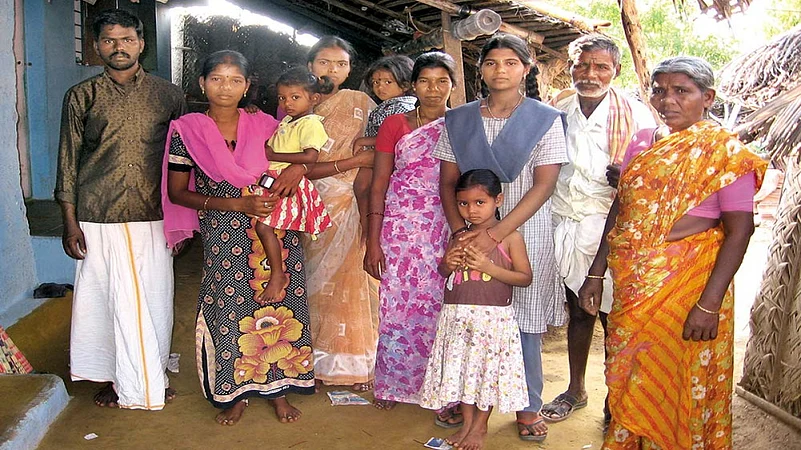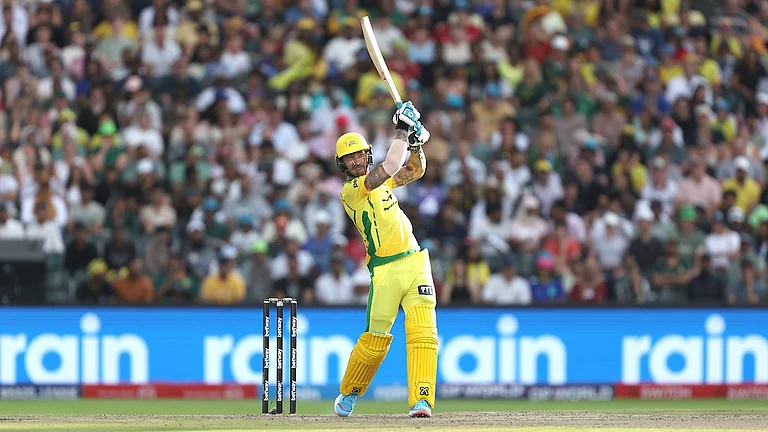Here, we take a step back from stories of individual success. The viewfinder is set to a wider landscape—to the infrastructural ground, the social and economic relations that determine Dalit mobility. Enabling it, or as often is the case, still thwarting it. Dr Judith Heyer, a development economist, has done a study on Dalit communities around Tiruppur and Coimbatore, Tamil Nadu, for over three decades, since 1981. It has been a time of economic surge, but in terms of its emancipatory potential, the results were partly disappointing. Here, she records her views through a series of pen-portraits.
The Coimbatore/Tiruppur region is known for its dynamic industrial development and strong agriculture. It is a region in which Dalits have done surprisingly badly. Very small numbers of Dalits own agricultural land. Dalits have been late-comers to education, are poorly represented in white-collar jobs and in business, large and small. This despite strong social policy, reservations and affirmative action. The villages that I have been researching, and on which this piece is based, are 50 km from Coimbatore and 25 km from Tiruppur, and off the main road. They have a good record in agriculture and have been more integrated into the local economy over time. The regional economy employs large numbers of people in textiles, engineering and other light industries, and more recently IT and the medical sector. Much of the employment is low-skill, low-wage employment, casual and irregular. Labour shortages in the area have been met with substantial immigration.
ALSO READ: Our Dalit, Every Inch A Hero
Aspirations have risen gradually in the Dalit community over the past 30 years or so, and there has been a gradual rise in capacity to meet these aspirations. There were impressive successes, involving hard work and determination, the overcoming of setbacks as well as good luck. There also were people for whom setbacks were difficult to overcome.
I have been puzzling over the fact that Dalits were facing such difficulties in a region that has been at the forefront of industrialisation for so long: that speaks of a very strong social inertia-like force that pulls them down even when they try to move. It’s a function of the fact that they operate from the margins, and through a constant precarity. The villages are dominated by caste Hindu agriculturalists; Dalit labourers live in settlements attached to villages. The larger group of Dalits, the Arunthathiyars, has never had more than a few very small landholdings. Many in the smaller group, Pallars, have small holdings of dry land now. Over the three decades I have been studying these villages, they have moved from classic agrarian villages with high levels of dependency on traditional forms of economic life, to those integrated into the growing regional economy. In the late 1980s and early 1990s, caste Hindu labourers entered the non-agricultural economy, leaving Dalits in a stronger position in villages. In the late 1990s and early 2000s, Dalits began to enter that economy as well, though many remained agricultural labourers with better conditions. The development of the local economy and expanding state welfare programmes led to significant improvements in standards of living for Dalits and others. But it’s still a largely grey palette, with streaks of white.
ALSO READ: Dalit Time
It was black, of course, to begin with. In the agrarian economy of the early ’80s, Dalits were uninterested in, and even resistant to, education and there was a lot of child labour. After the start of the noon meals programme (in 1984 in rural Tamil Nadu) and the democratisation of village administration, Dalits had direct interactions with state officials for the first time and more Dalits began sending children to school. By the mid-1990s, most Dalit children of primary school age were in school, and in 1996 the first Dalits completed the SSLC. In the 2000s and subsequently, several went into higher education. They put a lot of effort into encouraging others to pursue education. However, the costs to be borne for having young adults in school and college were high. What was important was that they had the aspirations, and that some were able to meet them.
Individual cases show both difficulties faced, and what underpinned the limited achievements. One such case was Muthan, a bonded labourer when I first met him in 1981, and the only Dalit there interested in education. When I next met him, in 1996, his son, Armugam, had just become one of the first from his community to complete his SSLC (secondary examination). Muthan felt defeated though. He felt he couldn’t support his son any further. Armugam was going to have to work as an agricultural labourer to make ends meet. By paying the equivalent of what Armugam would have earned thus, we persuaded Muthan to let him continue. Armugam had done sufficiently well in SSLC to get all direct costs of his schooling met by the state.
But when he was half way through the next year, his sister developed a stomach problem needing surgery, so they dipped into his school money and he went back to work as a labourer. When we heard about this, we got Armugam back to school. Then his grandmother died and the family needed money to give her a decent funeral. Repeat of previous episode. I wondered if trying to support him was going to work. However, when I next caught up with them, Armugam had done a teacher training course and they were saving up to pay the panchayat president to get him appointed panchayat secretary. Then he got a girl pregnant, married her, and used the savings intended for the panchayat secretaryship to pay for a Caesarean delivery. Eventually, after saving more money by working in Tiruppur, Armugam got a job in the VCACS office and then the coveted secretaryship. That enabled him to build a good house next to his father’s on the family plot. Muthan had once said: “I have worked so hard for so long and got only this far. My hopes for my son are that…he will get further than me”. This his son had done. The next generation was to do better. Muthan’s older daughter’s children had lived with him during their schooling. The son did a diploma in mechanical engineering and became a mechanic. The daughter was in her 3rd year in engineering college in 2018.
ALSO READ: They Lit The Torch, Caste Aside Darkness
A different case was that of Raman, one of very few Dalits here who managed to get some irrigated land. An agricultural labourer, he had started an agricultural products market (APM) cell in the villages before I met him in 1996. A few years later, he got into construction work in Tiruppur and joined the Democratic Youth Federation of India (DYFI). The APM did alright, he said, but it was not getting enough support in the village to sustain it. Through a chance reading in the local paper in the early 2000s, Raman knew about a scheme for Dalit women to get land. He applied on behalf of his wife, got 2.6 acres of well-irrigated land, and after some years an electricity connection. When I last met him, in 2018, he was sitting by a shack on his land, getting his borewell deepened, telling me though he felt good he hadn’t made any money from the land. He was continuing with farm labour and construction work. The problem: he knew how to cultivate crops, but did not know about money, or marketing, or deciding which crops to grow when. He valued the status of a landowner and got respect for it. The deepening of the well was courtesy a large loan; he did not know how it would work out.
The most successful of them all was Angan, who I first met in 2009 in a small group of young men who had completed Standard XII but were working as manual labourers. Angan used to work in an engineering workshop, but lost several fingers in an accident. Manual work became difficult. Instead, he studied, for years. One qualifying examination after another. He got admission to the government law school, and was apprenticed to a lawyer in Tiruppur. When I last met him, in 2018, he was a junior in a Tiruppur lawyer’s office, doing well. This was an exceptional case of someone who had had the strength and determination to turn misfortune into opportunity.

Upward struggle Members of a Dalit family in a Tamil Nadu village.
A few Dalits pursued business activities, or self-employment, where education was not necessarily required. But one such, Maran, who worked in a stitching unit in a nearby centre, Cheyur, for 7-8 years until his employer moved to Tiruppur and gave the Cheyur unit to Maran on lease, was supplying orders now. Maran, who only had two years of primary schooling, “knew all the work, including some machinery repair”. He took the lease for three years and then bought the machinery for Rs 3 lakh and started operating from a rented building. He could not sustain it though, power cuts being one of the things that undermined his efforts. He brought three stitching machines and two tables to his house in the Dalit settlement. His previous employee was still giving him orders, but took over the checking, ironing, and packing from Maran. In Cheyur, Maran had 10 employees. In the village, he only had himself and his wife—“for now”. When he had repaid his loans and stabilised his business, he planned to bring everything to the village and employ more people there. He bought a small building too. It was unclear whether he’d be successful. There were many failed businessmen in this area, mostly non-Dalits.
Another less successful case was that of an engineering student, Nanjan, the youngest of three brothers, who was struggling with his studies when I met him in 2014. The eldest brother, Kumaran, was working in a powerloom unit to fund his brother’s education. The middle brother was unable to help him. When I met them next, Kumaran was sick and Nanjan had dropped out and was working as a packer in Tiruppur. The family was indebted both to the powerloom owner and to Canara Bank, to which they had mortgaged their house. Nanjan’s SSLC marks had not been good enough for a state scholarship. Nanjan, now married with a child, was writing the exam for a Village Administration Officer’s (VAO) post.
There was a smattering of young Dalit women who had got degrees by correspondence and were working in shops and offices, hoping to progress. Other young Dalits, men and women, had got teacher training qualifications and were waiting to get government posts for which there were reservation but also long waits. Yet others who had worked hard, and had families working hard to support them, had been defeated along the way. It was so easy for sickness, an accident, a death, or some other event, to upset their plans. Gradually, though, a well of possibilities had been developing that had not been there before. Thus, there was progress over three decades or more in these villages. Aspirations had been rising, as had attempts to meet them. But progress was slow. Dalit lives and livelihoods were very fragile. The vicissitudes of life often proved to be their downfall, without the resources to weather them. The margins were too small. The success stories were impressive for all the hard work and persistence involved, but they also relied on good luck.
(The author is emeritus fellow, Somerville College, Oxford. Views expressed are personal.)





















